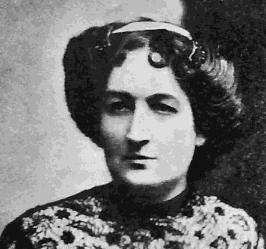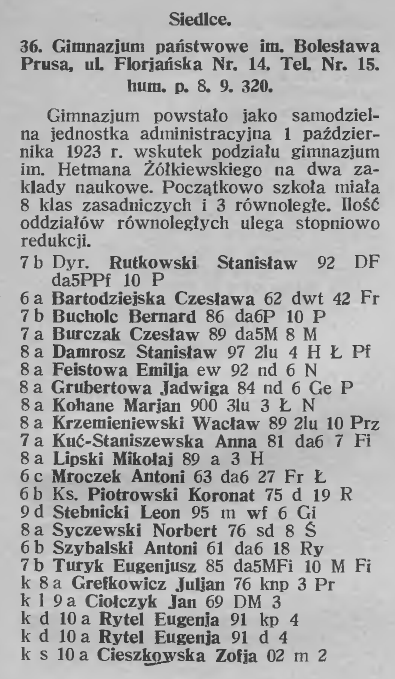 |
Date of Birth | 1867-12-15* | |||
| Place of Birth | Korczew-Dobiecin | ||||
| Date of Death | 1946-02-16 | ||||
| Place of Death | Wąglin | ||||
| Pseudonym and cryptonym | Sariusz; Sarjusz; Saryusz | ||||
| Familiar ties | of the Otocki family |
||||
| VIAF ID | 250187449 | ||||
Zofia Cieszkowska was born in 1867 in the area of Piotrków, and died in 1946. She was a writer; social activist; and democrat who fought for women’s rights, established schools, gardens and reading rooms for impoverished children. She also took part in teaching young students the French language, among other subjects.
In 1898, Cieszkowska began her writing career by writing the novel Jędrek Sokół (Jędrek the Falcon). She was aware of the difficulties of being a female storywriter in the artistic and literary world, and chose to write under a male pseudonym, which was one of the developmental factors in her literary talent. Zofia Cieszkowska cooperated with the magazine Bluszcz in Warsaw, which, for many years, showcased her literary works in parts. Some of her most important works include: Między świtem a dniem (Between Dawn and Day, 1902), Więzy ducha (Towers of The Soul, 1907-1908), Krzyk życia (The Shout of Life, 1911), Krzywdy dozwolone (Permitted Wrongdoings, 1914) and Literatka (The Writer, 1923). Cieszkowska also published a book about nature entitled Obyczaje zwierząt (Habits of Animals, 1923), in which she displayed her vast knowledge of biology. The young writer accumulated a large circle of female readers, and often in her novels included her own views on the topic of womens’ role in that day and age. Zofia Cieszkowska represented an environment of women emancipators, who also released novels of a didactic nature that represented their own ideals. Despite the fact that Cieszkowska belongs to the circle of forgotten female writers, she became very popular in the first half of the 20th century, and her books have since been an available resource in domestic libraries, parishes, and schools.
Through a social lens, the works of Zofia Cieszkowska concentrated mainly on activism related to education and learning. After a school strike in 1905, she became a principal of one of the Polish schools in Warsaw. She then started working on textbooks for Polish students in middle school, grades one, two and three; which she published in 1917 under her own name through J. Waleckiego printing in Piotrków. Around 1926 she worked as a contract teacher at the state middle school Gimnazjum Państwowe im. Bolesława Prusa (The Bolesław Prus State Middle School) in the town of Siedlce.
Currently, Stowarzyszenie Przyjaciół Wolborza (The Friends Association of Wolbórz) has been involved in propagating this female writer for many years.
In her novels, Cieszkowska provides a glimpse at the situation of women in the Młoda Polska (Young Poland) literary movement, as well as a world dominated by men and their right of ownership over women; to a certain extent. The writer most likely implemented her own biographical plots and experiences into her stories. For example, in Krzywdy dozwolone, she presents the steps of the divorce process (a divorce which did not end up happening in the end), hardships that the female protagonist wrestled with, and the unfortunate circumstances which accompanied the whole ordeal.
The plot in Krzywdy dozwolone portrays the female protagonist’s dissatisfaction with her community, where her worth is undermined and her dreams are crushed by a man who makes excuses for his actions by accusing his wife of not taking care of him. The main protagonist, Wandzia, is a dreamer whose hand is sought after by Bolesław; a man 15 years her senior, and her complete opposite. Tadeusz, the brother of Wandzia, supports and loves her sincerely and, witnessing her budding talent, strives to help her develop it. In the name of love and hope of domestic happiness, Wandzia gives up her dreams and becomes Bolesław’s wife. However, Bolesław leads a life of wasteful spending, squanders his estate, and emotionally abuses his wife, leading to her doom.
The story Literatka tells a tale of Lidka, a female writer with an artistic spirit, and her struggles in a world full of schemats and harsh realities. Lidka finds pleasure in writing, but she can’t find happiness in her relationships with men. After a failed attempt at marriage and losing her daughter, Lidka falls into despair. In a publishing house in Warsaw, she begins a new creative life under the pseudonym Halina, where she meets Zbigniew, a man who supports her emotionally and on her literature career journey. Thanks to their cooperation, her literary works were finally published.
Krzyk życia is a story written in the form of a diary (so-called confessional prose, which were very common in the Młoda Polska literary period), whose owner is a girl others call “Primavera” (because of her Art Nouveau hairstyle). After finishing university and writing her final work to graduate, the protagonist is challenged with her publication not being financially successful. Despite her parents being proud of her achievements, her joy quickly comes to an end when her published book does not bring in any income. Primavera then meets her sister’s admirer, Karol, who tries to seduce Primavera, but gets rejected. Years later, they start seeing each other again but he leaves her, so that one day he can return and exist in her life effectively. When Karol finds out that Primavera is pregnant, he forces her to get an abortion, but she decides to raise the child in the end. After finding out about the illegitimate child, her father expells her from the home, and she must now raise the child completely alone. Krzyk życia represents a suppressed scream about lost love, and a frenzy of feelings which Cieszkowska did not let out many years prior.
In the works of Zofia Cieszkowska one can also pinpoint her writing talent in her poetry, which her protagonists use. The women in her novels connect to many different things, representing pride and the trial of maintaining independence. Although these are not always artistically fulfilled women, they experience literary dilemmas and their creative inspiration manifests itself in a stormy catastrophe. They are fragile and delicate, but strong, dreaming about one great love to which they can devote themselves, and one that will devote itself to them. They search for self-value, and they want to prove this value to the world around them. Their main enemies are men who try to objectify them, who display their superiority, their power, and their dominance at every step.
The works of Zofia Cieszkowska also provide an interesting depiction of 20th century realities when women were already allowed to study at universities, but their fates were often sealed in the role of a wife and mother. It is worth analyzing the stories of Cieszkowska in depth, as well as understanding the hardships of the writer and her female protagonists in a world in which women had to conquer many obstacles in the pursuit of happiness.
WORKS
Autor, [In:] Na powodzian: ksiȩga zbiorowa prac literackich i artystycznych, pod kier. literackim S. Graybnera, Warszawa, Polska, Nakł. Lilpopa, 1904, s. 275-278.
Do czynu, „Dziennik Narodowy”, 1918, nr 56, (dodatek do nr 56, s. 1).
Do młodzieży, [In:] Na szkołę polską, ed. I.Dąbrowski, W. Rogowicz, Warszawa, Druk Piotra Laskauera, 1916, s. 67.
Do poety, [In:] Na wpisy szkolne : jednodniówka Tow. Literatów i Dziennikarzy Polskich : 7 maja 1915 r., Warszawa, 1915, s. 6.
Jędrek Sokół: powiastka, Warszawa,"Księgarnia Polska" Tow. Polskiej Macierzy Szkolnej, 1898, 1925.
Król tułacz i król chłopków: Władysław Łokietek, Kazimierz Wielki, Warszawa, Przegląd Katolicki, 1911.
Krzyk życia: szkic psychologiczny, Warszawa, L. Biliński i W. Maślankiewicz, 1911.
Krzyk życia: powieść, Lwów, Lektor, 1923.
Krzywdy dozwolone: powieść, Warszawa, Bibljoteka Domu Polskiego, 1926.
Krzywdy dozwolone, Warszawa, Księg. Światło, 1928.
Literatka: powieść, Poznań, nakł. Drukarni Poznańskiej, 1923.
List otwarty kobiet polskich do kobiet niemieckich, „Nowa Reforma”, 1908, nr 104, s. 2.
Między świtem a dniem: powieść, Warszawa, A. G. Dubowski, 1902.
Obyczaje zwierząt, Warszawa,"Księgarnia Polska" Tow. Polskiej Macierzy Szkolnej, 1928.
Podwójna moralność. Szkic powieściowy, „Bluszcz” 1907 nr 45, s. 511-513; nr 46, s. 522-523; nr 47, s. 529-531; nr 48, s. 543-545; nr 49, s. 553-554; nr 50, s. 564-565; nr 51, s. 577-578; nr 52, s. 584-586.
Polska w podziałach: Władysław Herman i Bolesław Krzywousty; Synowie Krzywoustego: Leszek Biały i Bolesław Wstydliwy, Warszawa, Przegląd Katolicki, 1912.
Starość, „Świt” : wiedza tajemna, 1935, nr 4, s. 1.
Szlachetni: obrazek z życia Samnitów, Warszawa, Księg. Krajowa K. Prószyński, 1904.
Twórcy państwa polskiego: Bolesław Chrobry, Mieczysław II, Kazimierz Odnowiciel, Bolesław Śmiały, Warszawa, Przegląd Katolicki, 1912.
Więzy ducha: powieść w dwóch tomach. T. 1, Warszawa, Bibljoteka Domu Polskiego, [1928].
Więzy ducha: powieść w dwóch tomach. T. 2, Warszawa, Bibljoteka Domu Polskiego, [1928].
Wspomnienie o śp. Mieczysławie Brzezińskim, „Bluszcz”, 1911, nr 10, s. 103.
Wypisy polskie na klasę I, Piotrków, [s.n.], 1918.
Wypisy polskie na klasę II, Piotrków, [s.n.], 1918.
Wypisy polskie na klasę III, Warszawa, [s.n.], 1918.
Ze vzpomi'nek roku 1905, [In:] Maternová P., Popławska S. D., Památník výstavy práce ženy polské v Praze, Praha, Vydání Ústředního Spolku Českých Žen , 1912, s. 82-87.
Literal transaltion
Mérimée P., Djana de Turgis: noc św. Bartłomieja, Mérimée P., Poznań, Sekwana, 1923.
Reynès-Monlaur M., "Patrzeć będą na Mnie"... = ("Ils regarderont vers lui"), Reynès-Monlaur M., Warszawa, M. Szczepkowski, 1911.
Short literary forms
Aforyzmy, [In:]: Album kobiece. Warszawa, Gebethner i Wolff, 1903, s.12, 14, 65, 69.
BIBLIOGRAPHY
A. Z., Zofia Cieszkowska Krzywdy dozwolone - [review], „Rodzina Polska”, 1933, nr 5, s. 152.
Cieszkowska z Otockich Zofia (pseud. Sarjusz), [In:] Czy wiesz kto to jest ?, ed. S. Łoza, Warszawa, Wydawnictwo Głównej Księgarni Wojskowej, 1938, s. 110.
Cieszkowska Zofja, [In:] Lechicki C., Przewodnik po beletrystyce, Poznań, Naczelny Instytut Akcji Katolickiej, 1935, s. 226.
C.W., Z powodu trzydziestolecia pracy literackiej i społecznej Zofji Cieszkowskiej?, "Kobieta Współczesna", 1928, nr 6, s. 17-18.
Czereśniewski W., Zofia Cieszkowska (Sariusz) Krzyk życia. Szkic psychologiczny…. , „Pion”, 1937, nr 40, s. 5.
Drogoszewski, A., Cieszkowska Zofja (Sarjusz) Krzyk życia – [review], „Książka”, 1913, nr 4, s. 189-190.
Kuźnicki T., Cieszkowska Zofia Helena Adela, ps. Saryusz: (1867-1946): powieściopisarka, poetka, nauczycielka i działaczka oświatowa, [In:] Radomszczański słownik biograficzny. T. 2, Radomsko, Polskie Towarzystwo Historyczne Oddział w Radomsku, 2019, s. 35-37.
Kuźnicki T., Kaplica cmentarna w Kletni jako miejsce pochówku przedstawicieli ziemiańskiego rodu Kamockich, „Zeszyty Radomszczańskie : prace z dziejów Radomska i powiatu radomszczańskiego”, 2020, T. 18, s. 265-302.
M. B. dr. x, W obronie pożytecznej ksiązki. (Na marginesie: Przewodnika po Beletrystyce Cz. Lechickiego), „Gazeta Kościelna”, 1935, nr 47, s. 509-511.
(m. p.). Śród książek, „Nowa Gazeta”, 1911, nr 370, s. 2.
Poradowski R., Zofia Cieszkowska - bojowniczka o prawa kobiet polskich. "Gazeta Radomszczańska" 1976, nr 6, s. 4-5.
Pruski Z., Kobieta bez inicjatywy… Z powodu „emacypantki" w trzecim wydaniu*, „Dziennik Piotrkowski” 1937, nr 247, s. 8.
Siniarski S., Kalendarz z dziejów Wolborza. 1065-1982, Warszawa, Instytut Wydawniczy Związków Zawodowych, 1984.
Słownik pseudonimów pisarzy polskich XV w. - 1970 r., T. 4, A-Ż., ed. E. Jankowski. Wrocław, Zakład Narodowy im. Ossolińskich, 1996, s. 99.
Sobieraj T., Tradycje - rewizje - kontynuacje. Wokół „światopoglądu" polskiej prozy okresu pozytywizmu, [In:] Literatura i sztuka drugiej połowy XIX wieku : światopoglądy, postawy, tradycje, ed. B. Bobrowska, S. Fita, J. A. Malik, Lublin, Towarzystwo Naukowe Katolickiego Uniwersytetu Lubelskiego, 2004, s. 230-231
Walęciuk-Dejneka B., Kobiece pisanie - trzy portrety : szkice o mniej znanej (nieznanej) literaturze kobiet przełomu XIX i XX wieku. Cz. 1., Siedlce, Wydawnictwo UwS, 2025. DOI: 10.34739/68355.51.2
Zacharska J., Lektury pensjonarek – bohaterek powieści przełomu wieków, [In:] Książka pokolenia. W kręgu lektur polskich doby postyczniowej, ed. E. Paczoska i J. Sztachelska, Białystok, Wydawnictwo Łuk, 1994. s. 138-148.
Zgliński D., Zofja Cieszkowska. (Sarjusz). Krzyk życia – [review], „Przegląd Wileński”, 1912, nr 1, s. 9-10.
 |
| Public Domain: In: Zagórowski Z., Spis nauczycieli szkół wyższych, średnich, zawodowych, seminarjów nauczycielskich |
Author biography: Wiktoria Świętuchowska
This work is licensed under a Creative Commons BY-NC Attribution - NonCommercial 4.0 license. License text





